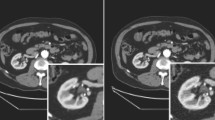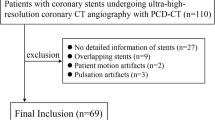Abstract
Purpose
To compare dual-energy computed tomography (CT) spectral imaging and conventional CT imaging in terms of precision of the measurement of CT numbers in phantoms.
Materials and methods
A circular phantom (CP) and an elliptical phantom (EP) were used. Capsules filled with iodine contrast media solutions at various concentration levels were placed in the phantoms. Conventional CT was performed at a tube voltage of 120 kVp. Simulated monochromatic images at 65 keV were obtained by dual-energy CT spectral imaging. The CT number of each iodine capsule was measured. A linear regression model was used to evaluate linearity, while analysis of covariance was used to investigate the degree of variability according to phantom shape for each imaging method.
Results
With conventional imaging, the slopes of the regression lines for CT numbers measured at the EP center and EP periphery were significantly lower than those measured for CP (P < 0.0001 for both EP center vs. CP and for EP periphery vs. CP). No significant difference in slope was found among phantom shapes in dual-energy spectral CT imaging.
Conclusion
Computed tomography numbers varied considerably depending on the phantom shape in conventional CT, whereas dual-energy CT provided consistent CT numbers regardless of the phantom shape.


Similar content being viewed by others
References
Levi C, Gray J, McCullough E, Hattery R. The unreliability of CT numbers as absolute values. Am J Roentgenol. 1982;139:443–7.
Zerhouni EA, Spivey JF, Morgan RH, Leo FP, Stitik FPa, Siegelman SS. Factors influencing quantitative CT measurements of solitary pulmonary nodules. J Comput Assist Tomogr. 1982;6:1075–87.
McCullough E, Morin R. CT-number variability in thoracic geometry. Am J Roentgenol. 1983;141:135–40.
Birnbaum BA, Hindman N, Lee J, Babb JS. Multi-detector row CT Attenuation measurements: assessment of intra- and interscanner variability with an anthropomorphic body CT phantom. Radiology. 2007;242:109–19.
Maki DD, Birnbaum BA, Chakraborty DP, Jacobs JE, Carvalho BM, Herman GT. Renal cyst pseudoenhancement: beam-hardening effects on CT numbers. Radiology. 1999;213:468–72.
Coulam CH, Sheafor DH, Leder RA, Paulson EK, DeLong DM, Nelson RC. Evaluation of pseudoenhancement of renal cysts during contrast-enhanced CT. Am J Roentgenol. 2000;174:493–8.
Bae KT, Heiken JP, Siegel CL, Bennett HF. Renal cysts: is attenuation artifactually increased on contrast-enhanced CT images? Radiology. 2000;216:792–6.
Birnbaum BA, Maki DD, Chakraborty DP, Jacobs JE, Babb JS. Renal cyst pseudoenhancement: evaluation with an anthropomorphic body CT phantom. Radiology. 2002;225:83–90.
Abdulla C, Kalra MK, Saini S, Maher MM, Ahmad A, Halpern E, et al. Pseudoenhancement of simulated renal cysts in a phantom using Different multidetector CT scanners. Am J Roentgenol. 2002;179:1473–6.
Heneghan JP, Spielmann AL, Sheafor DH, Kliewer MA, DeLong DM, Nelson RC. Pseudoenhancement of simple renal cysts: a comparison of single and multidetector helical CT. J Comput Assist Tomogr. 2002;26:90–4.
Israel GM, Bosniak MA. Pitfalls in renal mass evaluation and how to avoid them. Radiographics. 2008;28:1325–38.
Birnbaum BA, Hindman N, Lee J, Babb JS. Renal cyst pseudoenhancement: influence of multidetector CT reconstruction algorithm and scanner type in phantom model. Radiology. 2007;244:767–75.
Wang ZJ, Coakley FV, Fu Y, Joe BN, Prevrhal S, Landeras LA, et al. Renal cyst pseudoenhancement at multidetector CT: what are the effects of number of detectors and peak tube voltage? Radiology. 2008;248:910–6.
Graser A, Johnson TRC, Bader M, Staehler M, Haseke N, Nikolaou K, et al. Dual energy CT characterization of urinary calculi: initial in vitro and clinical experience. Invest Radiol. 2008;43:112–9.
Boll DT, Patil NA, Paulson EK, Merkle EM, Simmons WN, Pierre SA, et al. Renal stone assessment with dual-energy multidetector CT and advanced postprocessing techniques: improved characterization of renal stone composition—pilot study. Radiology. 2009;250:813–20.
Thomas C, Patschan O, Ketelsen D, Tsiflikas I, Reimann A, Brodoefel H, et al. Dual-energy CT for the characterization of urinary calculi: in vitro and in vivo evaluation of a low-dose scanning protocol. Eur Radiol. 2009;19:1553–9.
Alvarez RE, Macovski A. Energy-selective reconstruction in X-ray computerized tomography. Phys Med Biol. 1976;21:733–44.
Wu X, Langan DA, Xu D, Benson TM, Pack JD, Schmitz AM, et al. Monochromatic CT image representation via fast switching dual kVp. In: Proceedings of the SPIE, vol. 7258; 2009. p. 725845.
Joseph PM, Spital RD. The effects of scatter in X-ray computed tomography. Med Phys. 1982;9:464–72.
Vetter JR, Holden JE. Correction for scattered radiation and other background signals in dual-energy computed tomography material thickness measurements. Med Phys. 1988;15:726–31.
van Erkel AR, van Gils AP, Lequin M, Kruitwagen C, Bloem JL, Falke TH. CT and MR distinction of adenomas and nonadenomas of the adrenal gland. J Comput Assist Tomogr. 1994;18:432–8.
McNicholas MM, Lee MJ, Mayo-Smith WW, Hahn PF, Boland GW, Mueller PR. An imaging algorithm for the differential diagnosis of adrenal adenomas and metastases. Am J Roentgenol. 1995;165:1453–9.
Miyake H, Takaki H, Matsumoto S, Yoshida S, Maeda T, Mori H. Adrenal nonhyperfunctioning adenoma and nonadenoma: CT attenuation value as discriminative index. Abdom Imaging. 1995;20:559–62.
Korobkin M, Brodeur FJ, Yutzy GG, Francis IR, Quint LE, Dunnick NR, et al. Differentiation of adrenal adenomas from nonadenomas using CT attenuation values. Am J Roentgenol. 1996;166:531–6.
Acknowledgments
We gratefully acknowledge Kosuke Sasaki, M.S., and Koji Segawa, R.T., for their technical support and assistance in data acquisition.
Author information
Authors and Affiliations
Corresponding author
About this article
Cite this article
Matsuda, I., Akahane, M., Sato, J. et al. Precision of the measurement of CT numbers: comparison of dual-energy CT spectral imaging with fast kVp switching and conventional CT with phantoms. Jpn J Radiol 30, 34–39 (2012). https://doi.org/10.1007/s11604-011-0004-0
Received:
Accepted:
Published:
Issue Date:
DOI: https://doi.org/10.1007/s11604-011-0004-0




